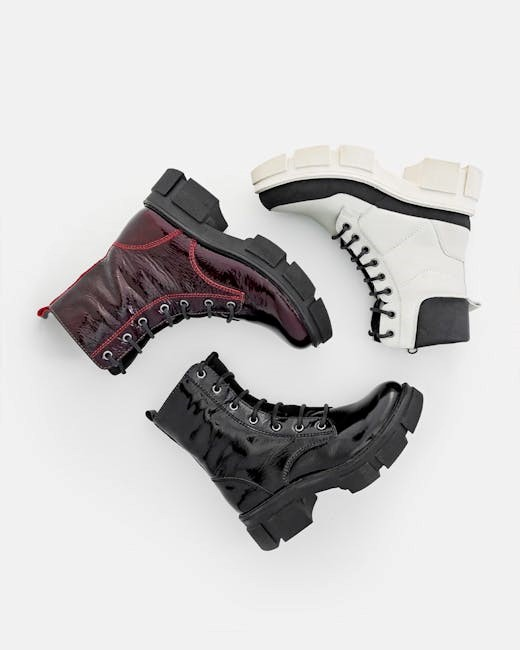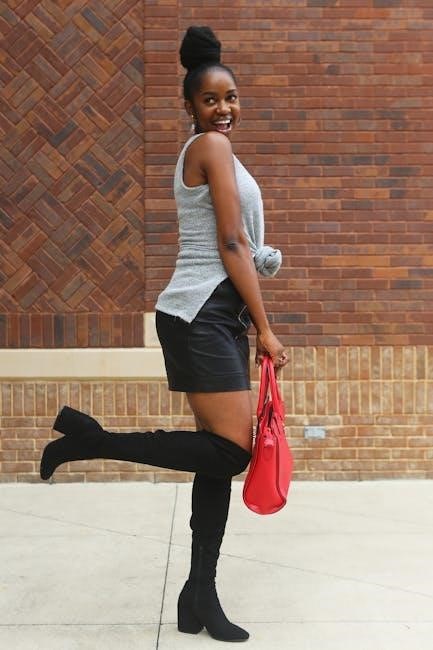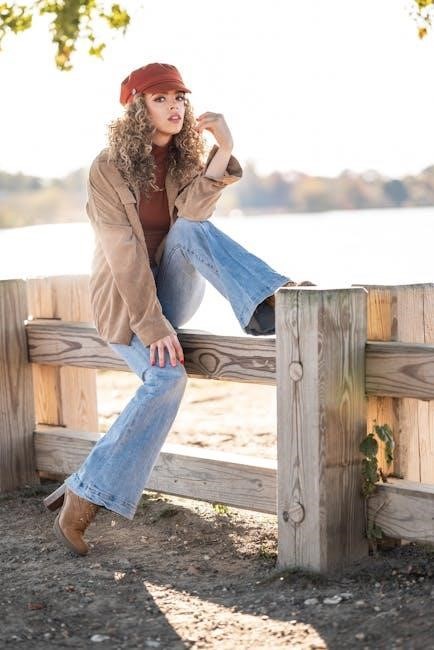
Red Wing boots are renowned for their comfort and durability, but sizing can be confusing. This guide helps you navigate their unique fit nuances, ensuring the perfect match for your feet.
1.1 Importance of Proper Fit
Proper fit is essential for comfort and performance in Red Wing boots. Ill-fitting boots can cause discomfort, affect durability, and hinder performance. Red Wing boots often run larger than sneaker sizes, so sizing down may be necessary. Consider width options and sock thickness to ensure the best fit. Incorrect sizing can lead to returns, so careful measurement is key. Prioritizing proper fit guarantees optimal comfort and longevity of your Red Wing boots, ensuring they meet their reputation for exceptional quality.
1.2 Overview of Red Wing Sizing Nuances
Red Wing boots have unique sizing characteristics that differ from standard footwear. They often fit larger, requiring many to size down by half to a full size. Width options vary, with most men’s styles in D and women’s in B, while some models offer EE for wider feet. Foot shape, sock thickness, and specific models like Moc Toe or Iron Ranger can influence fit. Understanding these nuances ensures a tailored fit, aligning with Red Wing’s commitment to comfort and durability.
How Red Wing Boots Fit
Red Wing boots generally fit larger than sneaker sizes, often requiring a half to full size down. Foot shape and width significantly impact the fit.
2.1 Size Difference from Sneakers
Red Wing boots typically run larger than sneaker sizes, often requiring a half to full size smaller. This difference is due to their roomier design and lasts. For example, if you wear a size 11 in sneakers, a 10.5 in Red Wings may fit better. Narrower feet might need a full size down, while wider feet may need less adjustment. Proper sizing ensures optimal comfort and performance.
2.2 Width Options
Red Wing boots offer various width options, ranging from A (narrow) to 3E (extra-wide). The standard width for men is D, while women’s boots typically come in B. Widths like EE and 3E cater to wider feet, ensuring a comfortable fit without tightness. Models like the Iron Ranger often come in E widths, while specific styles, such as the 6-inch safety boots, may offer EE widths. Choosing the right width ensures proper toe room and prevents discomfort, making it crucial for long-lasting wear and support.

Standard Red Wing Sizing Charts
Red Wing provides detailed sizing charts for men and women, including US, EU, and UK sizes with centimeter measurements. These charts help ensure accurate fit based on foot length and width, catering to various lasts and styles. Referencing these charts is essential for selecting the correct size, as Red Wing boots may differ from other brands; Proper measurement is key to a comfortable and durable fit.
3.1 Men’s Size Chart
Red Wing’s men’s size chart offers a comprehensive guide, including US, EU, and UK sizes, along with centimeter measurements. The chart caters to various foot lengths and widths, with standard D-width fittings for most models. Some styles, like the Iron Ranger, may vary slightly. The chart is organized by last type, ensuring accuracy across different boot styles. Proper measurement using a Brannock device is recommended to match your foot size precisely. This chart is indispensable for selecting the right fit, considering Red Wing boots often run larger than sneaker sizes.
3.2 Women’s Size Chart
Red Wing’s women’s size chart provides a detailed guide for selecting the perfect fit. It includes US, EU, and UK sizes, along with corresponding centimeter measurements. The chart is designed to accommodate various foot lengths and widths, ensuring comfort and durability. Women’s boots typically feature a standard B-width fitting, though specific styles may vary. Proper measurement is crucial, as Red Wing boots often run larger than sneaker sizes. Use this chart to align your foot size with the ideal boot size for optimal comfort and performance.

Factors Affecting Boot Fit
Foot shape, sock thickness, and personal comfort preferences significantly impact boot fit. Understanding these factors helps ensure a comfortable and accurate size selection for Red Wing boots.
4.1 Foot Shape
Foot shape plays a crucial role in boot fit, as Red Wing boots are designed to accommodate various foot types. Narrow, medium, or wide feet require different sizing approaches. For instance, individuals with narrower feet may need to size down, while those with wider feet should consider Red Wing’s wider width options. The shape of the toe box and heel also matter, as they must align with your foot’s natural contours for optimal comfort and support. Proper fit ensures both functionality and long-lasting wear.
4.2 Sock Thickness
Sock thickness significantly impacts boot fit. Thicker socks take up more space inside the boot, potentially requiring a larger size. Red Wing boots are designed to accommodate various sock thicknesses, but it’s crucial to consider this when sizing. If you plan to wear heavy-duty work socks, you may need to size up slightly. Conversely, thinner socks may mean staying true to size. Always try boots on with the socks you intend to wear for the most accurate fit and comfort. This ensures optimal performance and all-day wearability.
Sizing Tips for Specific Models
Red Wing boots vary slightly by model due to design and last shape. Some styles, like Moc Toes, may require sizing down, while others fit true to size. Always consider foot shape and intended use when selecting specific models for the best fit.
5.1 Moc Toe Sizing
Moc Toe boots tend to run larger than typical Red Wing styles. Most users recommend sizing down by half a size for the best fit. This is because the Moc Toe features a roomier toe box, which can feel loose if not properly adjusted. For narrower feet, consider going down a full size. Additionally, factors like sock thickness and daily wear can influence the ideal fit, so personal preference plays a significant role in achieving comfort and support.
5.2 Iron Ranger Sizing
Iron Ranger boots typically run a full size larger than sneaker sizes. Most users recommend sizing down by a full size for the best fit. The Iron Ranger features a roomier toe box and a more substantial sole, which can feel loose if not properly adjusted. For narrower feet, consider going down a full size, while wider feet may prefer a half-size reduction. Sock thickness and personal comfort preferences also play a role in achieving the ideal fit.
5.3 Blacksmith Sizing
Blacksmith boots generally fit true to size but may vary slightly depending on foot shape. Those with narrower feet might opt for a half-size smaller, while wider feet may prefer their standard size. The boot’s streamlined design offers a snug yet comfortable fit. Sock thickness can impact comfort, so consider thicker socks for colder conditions. As with other Red Wing models, sizing down by a half size is common for sneakers-to-boots transitions. Ensure proper fit by trying them on in the afternoon and with your usual socks for optimal comfort.
Measuring Your Feet Correctly
Accurate foot measurement is crucial for the perfect fit. Use reliable tools to ensure consistency and precise sizing, avoiding common mistakes that lead to discomfort.
6.1 Using a Brannock Device
A Brannock device is a reliable tool for measuring foot length and width. It provides precise measurements, ensuring accurate size selection. Place your foot flat, align the heel with the end, and slide until snug. This method helps determine both length and width, crucial for proper fit. Regular use ensures consistency, especially as foot size can change over time. Red Wing recommends using a Brannock device for accurate sizing, aligning with their commitment to comfort and durability.
6.2 Digital Foot Scanning
Digital foot scanning offers a modern approach to measuring foot size. It captures precise arch height, length, and width, providing a detailed profile. This technology helps in recommending the ideal boot size, ensuring a comfortable fit. Some retailers use scanners like Volumental, which create a 3D model of your foot. This method is especially useful for online shoppers, reducing the guesswork in sizing. Red Wing Shoes collaborates with FitTech companies to enhance accuracy, making the fitting process efficient and personalized.

How to Try On Boots
Try boots in the afternoon, as feet tend to swell. Wear the same socks you plan to use with the boots for an accurate fit.
7.1 Best Time to Try On
The best time to try on boots is in the afternoon, as feet naturally swell throughout the day. This ensures a more accurate fit. Wear the same socks you plan to use with the boots, and consider the width and comfort. Red Wing boots are known for their durability, but proper sizing is key. Trying them on later in the day helps avoid tightness and discomfort. This simple tip can make a significant difference in long-term comfort and satisfaction with your boots.
7.2 Wearing the Right Socks
When trying on boots, wear socks similar to those you’ll use daily. Thicker socks can affect fit, potentially requiring a larger size. Red Wing boots are designed for comfort, but improper sock choice can lead to discomfort or tightness. Opt for breathable, moisture-wicking options to maintain foot health. Avoid overly bulky socks that may restrict movement. Ensuring the right sock-boot combination is crucial for long-term satisfaction and proper fit, especially in work or rugged conditions where performance matters most.
Common Mistakes to Avoid
Not sizing down, ignoring width options, and failing to try boots on properly are common errors that can lead to an uncomfortable or ill-fitting purchase.
8.1 Not Sizing Down
One of the most common mistakes when purchasing Red Wing boots is not sizing down. Red Wing boots tend to run larger than sneaker sizes, so opting for a half to full size smaller is often necessary. Failing to do so can result in a loose fit, causing discomfort and affecting performance. Ensure to consider this adjustment to achieve the optimal fit and comfort that Red Wing boots are known for.
8.2 Ignoring Width
Ignoring width is a common mistake when sizing Red Wing boots. Red Wing offers various widths, from narrow (A) to extra wide (3E), to accommodate different foot shapes. Neglecting to consider width can lead to discomfort or a poor fit. For instance, those with narrower feet may need a smaller width, while broader feet require more space. Failing to account for width can result in boots that feel too tight or too loose, ultimately affecting both comfort and performance.
Red Wing Boots Sizing FAQs
Discover answers to common questions about Red Wing boot sizing, fitting, and returns, ensuring you make informed decisions for the perfect fit and comfort.
9.1 Do Red Wing Boots Run True to Size?
Red Wing boots generally run larger than typical shoe sizes. Most users find they need to size down by half to a full size for the best fit. If you have narrower feet, sizing down a full size is recommended, while those with average or wider feet may prefer a half-size reduction. However, sizing can vary slightly depending on the specific model and last. Always refer to the official size chart or consult a professional fitter for accuracy.
9.2 Can I Return Boots if They Don’t Fit?
Yes, Red Wing boots can typically be returned if they don’t fit properly. Most retailers offer a return policy, often within 30 days of purchase, provided the boots are in new, unworn condition with all original tags and packaging. However, return policies may vary depending on the retailer, so it’s essential to check their specific terms before purchasing. Ensuring the best fit is crucial, as exchanges or refunds may not be possible if the boots show signs of wear.

The Importance of Width in Red Wing Boots
Proper width ensures comfort and functionality. Red Wing offers options like D, EE, and B to cater to different foot shapes, enhancing overall fit and performance.
10.1 Understanding Width Options
Red Wing boots offer various width options to accommodate different foot shapes. Standard widths include D for men and B for women, with options like EE for wider feet and A for narrower feet. Understanding your foot shape is key to selecting the right width. For example, wider feet may require an EE, while narrower feet may prefer a B or A. This ensures optimal comfort and prevents issues like tightness or excessive movement. Proper width selection enhances both fit and performance, making it a critical factor in choosing the right pair of Red Wing boots.
10.2 How to Choose the Right Width
Choosing the right width for Red Wing boots involves assessing your foot shape and personal comfort preferences. For narrower feet, opt for A or B widths, while wider feet may require EE or 3E. Consider your activity level and sock thickness, as these can affect fit. If you plan to wear thick socks, a slightly wider boot may be necessary. Use a Brannock device or digital scanning for precise measurements, and try boots on in the afternoon, as feet tend to swell during the day. This ensures a comfortable, snug fit tailored to your needs.

Orthotics and Insoles in Red Wing Boots
Orthotics and custom insoles can enhance comfort and support in Red Wing boots. Ensure proper fit by considering insole thickness and shape, as they may affect sizing accuracy.
11.1 Using Custom Insoles
Custom insoles can enhance comfort and support in Red Wing boots, especially for individuals with specific foot needs. They are designed to mold to your foot shape, providing arch support or cushioning where needed. However, adding insoles can affect the overall fit, as they take up space inside the boot. To ensure proper sizing, consider the thickness of the insole and how it may alter the boot’s fit. It’s recommended to try boots with your intended insoles or consult a professional to avoid sizing mismatches. Additionally, some Red Wing boots feature removable insoles, making it easier to integrate custom ones seamlessly. By balancing support and fit, custom insoles can elevate your comfort without compromising the boot’s performance or durability.
11.2 Impact on Sizing
Custom insoles can affect Red Wing boot sizing by reducing the internal space. Thicker insoles may require a larger size to maintain comfort, while thinner ones have less impact. Foot shape also plays a role, as wider feet may need more space. When using insoles, try boots with them inserted to ensure proper fit. Red Wing boots with removable insoles offer flexibility, but sizing adjustments may still be necessary. Always consider insole thickness when selecting your size to avoid tightness or discomfort during wear.

Caring for Your Red Wing Boots
Proper care ensures longevity and comfort. Condition leather regularly, clean thoroughly, and allow boots to rest between wearings to maintain shape and prevent excessive wear.
12.1 Break-In Period
The break-in period for Red Wing boots is crucial for achieving a comfortable fit. Most users report that it takes 1-2 weeks of regular wear for the leather to mold to their feet. During this time, it’s essential to wear the same thickness of socks you plan to use long-term. Red Wing’s sturdy construction means the boots will feel tight initially but will gradually soften and conform. Patience during this phase ensures a customized fit and prevents discomfort. Proper care and conditioning can also help accelerate the break-in process, making the boots more comfortable sooner. Additionally, some models, like the Iron Ranger, are known for their longer break-in periods due to their robust design. Consistent wear is key to breaking them in effectively without causing excessive strain on the feet. By following these steps, you can enjoy the durability and support Red Wing boots are known for while maintaining optimal comfort.
12.2 Maintaining Fit Over Time
Proper care ensures Red Wing boots maintain their fit over time. Regular conditioning keeps the leather soft and supple, preventing cracking. Avoid extreme heat, which can cause stretching or distortion. Store boots in a cool, dry place to preserve shape. Rotate between pairs to distribute wear evenly. Over time, the leather molds to your feet, enhancing comfort. Avoid over-conditioning, as it may soften the leather excessively. Use a shoe tree or stuff boots with paper to retain shape when not worn. This ensures long-lasting fit and durability.
Red Wing boots offer unmatched comfort and durability when sized correctly. By understanding fit nuances, foot shape, and width, you can enjoy years of reliable performance and satisfaction.
13.1 Final Tips for Perfect Fit
For the best fit, size down ½ to 1 full size from your sneaker size, considering foot shape and width. Try boots in the afternoon, as feet swell slightly. Wear thick socks if planned. Ensure toe room and snug heel fit. Use a Brannock device or digital scan for accuracy; Don’t ignore width options—narrow feet may need a smaller size. Visit a store for professional measurement if possible. Patience ensures long-term comfort and durability in your Red Wing boots.